How to scale Social Innovations from one context to another?
Exploring and developing design tools to facilitate social innovators scaling and achieving large-size impact
With a maturing design discipline increasingly gaining popularity outside the design domain, the focus of designers is no longer on solving problems through meaningful products and services only. As Manzini states ‘designers can take the role of facilitators and mediators, who ease transitions and make things happen.’ (Manzini, 2014, p.65-66)
In the course, Strategic Design for Social Innovation Ingrid Mulder stresses, that this role of design is still in its infancy, and it needs more exploration and experimentation. There is ample literature on how design contributes to supporting social/urban innovations through creative processes for idea generation, but those innovations often lack the inclusion of implementation phases. As societal challenges are so deeply rooted in the behaviour and perception of people, it is essential to focus on scaling innovations to trigger systemic change.
Following the course, Strategic Design for Social Innovation triggered and motivated Chiara to explore how to help social innovations scale through design.
Therefore, she took the chance to graduate with the PCM Lab and conduct her research with the urban innovators selected in DESIGNSCAPES Project’s 3rd Open Call on Scaling. In line with DESIGNSCAPES’ aim to ignite the transformative power of design for sustainable and responsible innovation in European cities, Chiara saw a great opportunity to contribute and add knowledge on design’s value in supporting the implementation and scaling phases of social innovations.
Turning the cognitive and context gap in opportunities for Design
Despite being successful solutions well embedded in one urban context, social innovations cannot easily be replicated to other cities or institutionalised to scale their impact. These innovations often fail to take root in new contexts because of several (contextual) barriers and other internal challenges, such as lack of expertise or financial resources. In particular, in hyper-localised social projects tackling global issues at a local level; hence, deeply embedded in the socio-cultural context and local ecosystem of networks and resources.
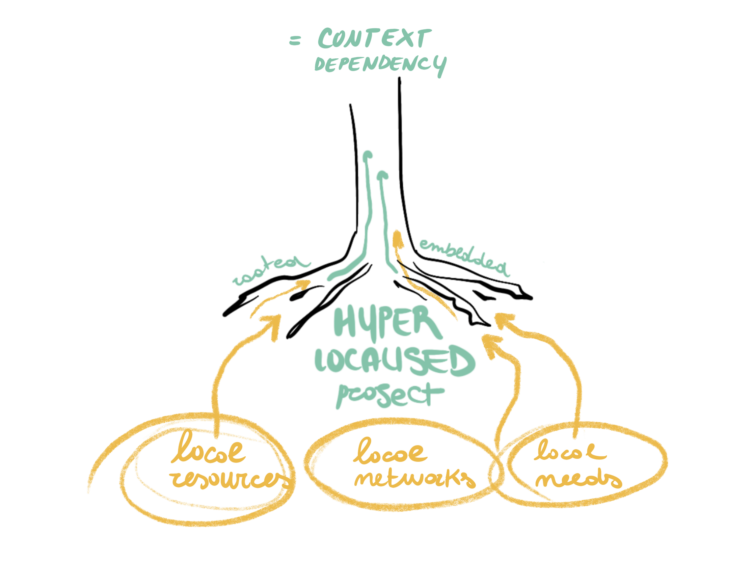
Chiara discovered that these social innovators face two main challenges influencing their capacity to scale and replicate in new contexts. Urban Innovators will have to overcome a cognitive and context gap, in fact when transferring to an unknown and unfamiliar place, the context conditions changes, such as the needs of the people, the culture, and the social infrastructure. Such unpredictability was perceived as threatening for the initiatives as showed by the following quote from an urban innovator.
The biggest worries I have on replicating Ticket to Change in Sicily is the lack of willingness on spending money from the participants on this kind of program… so the lack of the same economic and social fabric that we find in Paris and France are very different compared to Sicily.
Hannah Rasper, Ticket to Change
As another innovator (Filip from Crosswalk) stated “We also know that there is a lot we don’t know”, and because of that lack of knowledge, many initiatives are not yet aware/sure of what is worth scaling, adapting or replicating of their innovation.
The value of design to empower Social Innovators to overcome scaling challenges
In other words, Social Innovators need to define what to Scale before deciding how to scale and develop strategies. In this way matching their own goals and aspirations with the needs of the people and the local resources available. By talking with initiatives in DESIGNSCAPES, Chiara realised that they needed guidance to proceed with confidence toward their goals. Hence, she saw the opportunity to contribute by providing them with the capacity and tools to flourish in their full potential and empower their decision-making process to scale. By analysing the social initiatives’ challenges through various lenses, Chiara eventually derived the following main barriers when it comes to scaling:
- building a sustainable business model
- aligning demand and supply
- building advocacy among the local community
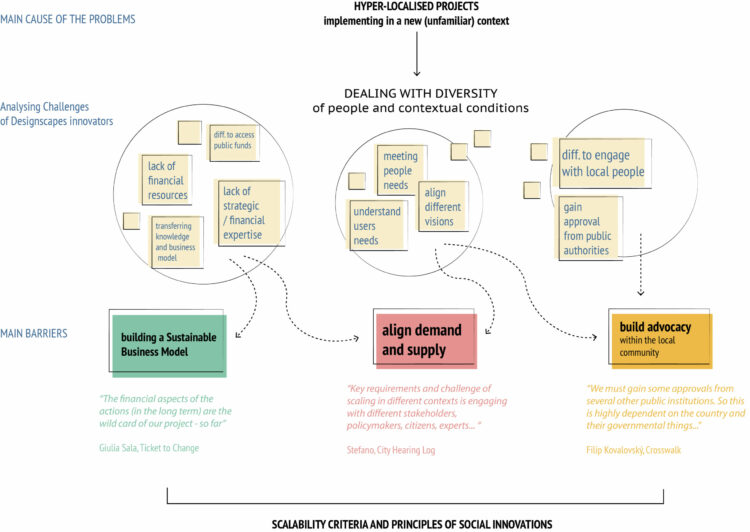
The Scaling Framework for Social Innovations
With her design knowledge, Chiara turned then these challenges into opportunities, and translated them into three main ‘Scalability Criteria and Principles of Social Innovations‘. So that by activating and considering all three criteria, a feasible and desirable solution could be scaled to achieve impact.
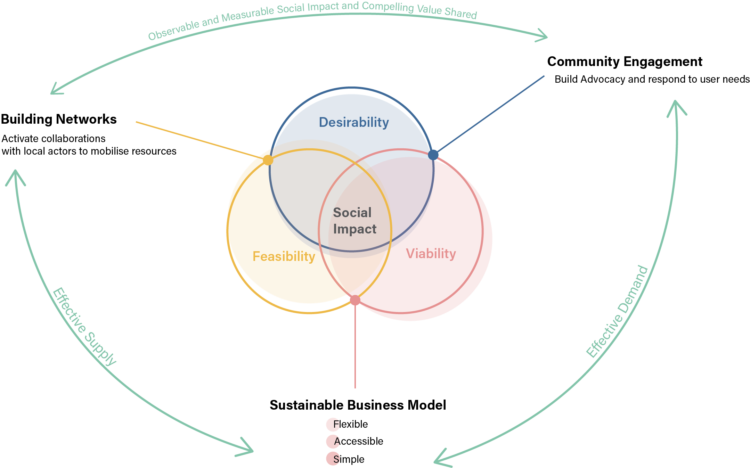
Moreover, by carrying out several research and design activities with innovators, Chiara also learned the importance of collaboration and participation as factors that and enable innovations to thrive. In fact, to disseminate/replicate a certain culture, innovators need to engage with, collaborate, and exchange values, knowledge, experiences.
It is vital to have a network of support […] like a network of like-minded people that Have the same passion for seeing a positive change in the world.
Diana Popa, Extensio
…when scaling it is essential to transfer know-how with the network of stakeholders
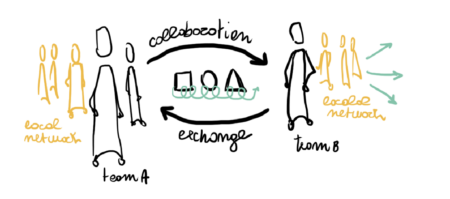
A good way to do so, and a crucial strategy enabling innovators to implement their projects in new contexts, is through network formation. However, before activate those strategic collaborations and forming local networks some crucial steps need to be followed. Chiara learned that while unfolding the scaling processes of Designscapes initiatives. Therefore, adding to the already mentioned Scalability Criteria, Chiara also identified and visualized those main steps in a ‘Scaling Process Map‘, which together came to form what she called the ‘Scaling Framework’: visual guidance to empower and support Social Innovators to scale from one context to another.
The framework shows how design functions as a guiding process for innovation, taking innovators through a particular thinking process (Manzini 2015).
A Design Tool-Box to Scale Social Innovations
Next, to make the framework actionable, operational and therefore useful for the urban innovators willing to scale their impact, Chiara translated her research outcomes and learnings into a design Tool-Box for scaling.
To respond to the innovators’ needs and with the initial willingness to explore the value of design for scaling social innovations, she used different design elements and approaches, which were eventually employed in the final result. For instance, she used metaphors to engage with and facilitate (online) participatory sessions, or she used strategic roadmap techniques to ignite decision-making processes and strategies development.
The Tool-Box she implemented supports the users in overcoming the scaling challenges and empowering them to proceed with confidence in their scaling journey. Other than the Scaling Framework, the toolbox includes multiple elements.
A set of Action Cards providing support and inspiration, intended to trigger reflection and discussion among the team while making decisions about their next steps and strategies. Those include the Probing Cards and the Strategic Cards.
Two main activities, which focus on the crucial steps of the scaling process: Acknowledging, Capturing What to Scale and Articulating How to Scale; so that Social Innovators will be able to bridge the Cognitive and Context gaps to replicate and implement in the new context through network formation.
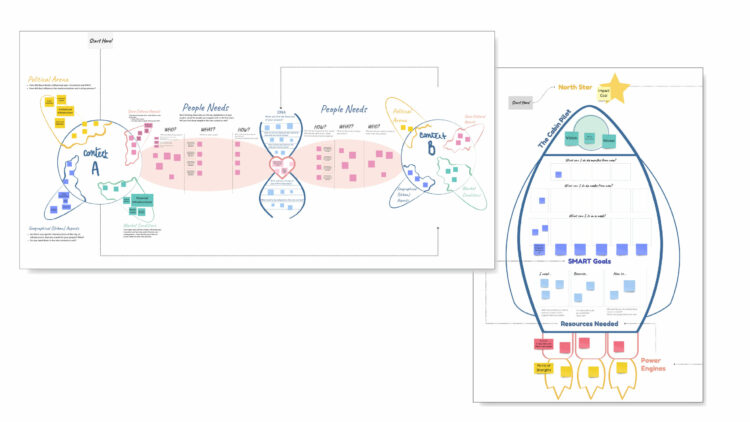
A Strategic Blueprint and Action Roadmap aiming to make the scaling process more feasible by visualising the activities and actions the social innovators should follow to achieve their impact goals.

An online Workshop Set-Up that provides the innovators with a flexible and creative working space to make use of the scaling tools and activities. Chiara designed the workshop on Miro and she made it accessible and user-friendly thanks to the use of step-by-step guidance in the form of metaphorical and visual storytelling: ‘Scaling as an Interstellar Journey’.
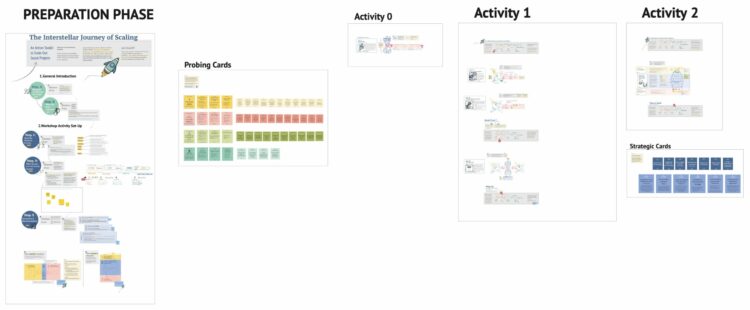
Why a design Toolbox?
Validating her toolbox with DESIGNSCAPES initiatives and other expert designers, Chiara found it is desirable and relevant, as it responds to various needs and purposes of different types of users and scaling scenarios. One of its benefits is that it allows for reflecting while triggering concrete actions and goals, supporting Social Innovators to activate strategic collaborations with the local actors. Moreover, it proved to be attractive thanks to its ‘fun and light’ setting which helps turn abstract thoughts into tangible and concrete actions to scale.
Conclusions & Main Takeaways
Overall, the project seems to be a first step toward achieving a large-size social impact and provide an example of how design can be applied to contribute to a more conscious and autonomous self-development of social innovators, empowering them to overcome their scaling challenges towards systemic transitions.
Through this journey, Chiara learnt that scaling a project from a context to another means capturing what and how to scale. Once innovators bridge their cognitive gap, they are more able to define how to adapt their project,matching the local needs and resources with their own goals and internal resources. To do so, they will articulate strategies, set goals and activate collaborations with local networks, mobilizing resources, aligning demand and supply, and finally implementing their project effectively in a new place.
In the end, Chiara is grateful for having had the opportunity of carrying a research project within the Participatory Making Lab, she realized the importance of participation, collaboration and open mindset to make a change and have an impact.
Her main takeaways: designers are great connectors; they have the power of capturing and creating value, empowering people and facilitating collaborations among different stakeholders to bring change. Indeed, this is how she wants to position herself as a strategic designer for her future career.
If you are curious to learn about the toolbox and even try it out yourself in a Workshop Setting on Miro, click on this link. For more in-depth information about the project and its outcomes, check out her report.
Written by Chiara Marradi, the work described in this article is part of a graduation project held in collaboration with DESIGNSCAPES and supervised by Alicia Calderon Gonzalez and Ingrid Mulder.